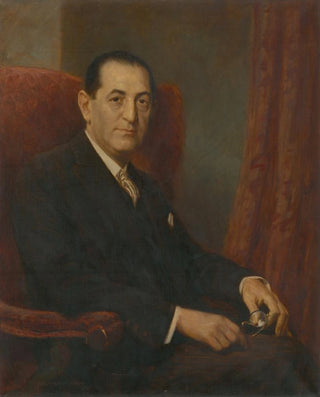Art print | Portrait of a man - Elemér Halász-Hradil


View from behind

Frame (optional)
Portrait of a Man - Elemér Halász-Hradil – Captivating Introduction
The "Portrait of a Man" by Elemér Halász-Hradil is a work that invites contemplation and reflection. This painting, both understated and emotionally charged, immerses us in the intimacy of a face, that of a man whose story seems to unfold through each brushstroke. Light plays a crucial role in this composition, revealing the nuances of the subject's personality. As you approach this art print, you cannot help but feel a deep connection with the model, as if time has stopped to allow us to explore his soul. Halász-Hradil's art transcends simple representation; it goes beyond traditional portraiture to capture the very essence of humanity.
Style and uniqueness of the work
Elemér Halász-Hradil's style is distinguished by his ability to combine realism and expressiveness. In "Portrait of a Man," every detail is carefully crafted, from facial features to delicate shadows that sculpt the form. The artist uses a subtle color palette, where warm and cool tones blend harmoniously, creating an atmosphere imbued with depth and mystery. What makes this art print particularly singular is the way Halász-Hradil manages to breathe palpable life into his subject. The eyes, in particular, seem to tell a story, a silent melody that resonates with the viewer. This portrait does not merely freeze a moment; it invites an exploration of human psyche, an immersion into the thoughts and emotions of the depicted character.
The artist and his influence
Elemér Halász-Hradil is an artist whose journey is marked by an unceasing quest for truth and authenticity. Born into a rich artistic context, he has established himself as an emblematic figure of modern portraiture. His work reflects a time when the individual is at the center of artistic concerns. Influenced by the great masters of the past, Halász-Hradil has reinterpreted classical techniques to adapt them to his personal vision. His approach to portraiture goes beyond mere physical representation; it is an exploration of human emotions, a search for what

Matte finish

View from behind

Frame (optional)
Portrait of a Man - Elemér Halász-Hradil – Captivating Introduction
The "Portrait of a Man" by Elemér Halász-Hradil is a work that invites contemplation and reflection. This painting, both understated and emotionally charged, immerses us in the intimacy of a face, that of a man whose story seems to unfold through each brushstroke. Light plays a crucial role in this composition, revealing the nuances of the subject's personality. As you approach this art print, you cannot help but feel a deep connection with the model, as if time has stopped to allow us to explore his soul. Halász-Hradil's art transcends simple representation; it goes beyond traditional portraiture to capture the very essence of humanity.
Style and uniqueness of the work
Elemér Halász-Hradil's style is distinguished by his ability to combine realism and expressiveness. In "Portrait of a Man," every detail is carefully crafted, from facial features to delicate shadows that sculpt the form. The artist uses a subtle color palette, where warm and cool tones blend harmoniously, creating an atmosphere imbued with depth and mystery. What makes this art print particularly singular is the way Halász-Hradil manages to breathe palpable life into his subject. The eyes, in particular, seem to tell a story, a silent melody that resonates with the viewer. This portrait does not merely freeze a moment; it invites an exploration of human psyche, an immersion into the thoughts and emotions of the depicted character.
The artist and his influence
Elemér Halász-Hradil is an artist whose journey is marked by an unceasing quest for truth and authenticity. Born into a rich artistic context, he has established himself as an emblematic figure of modern portraiture. His work reflects a time when the individual is at the center of artistic concerns. Influenced by the great masters of the past, Halász-Hradil has reinterpreted classical techniques to adapt them to his personal vision. His approach to portraiture goes beyond mere physical representation; it is an exploration of human emotions, a search for what






